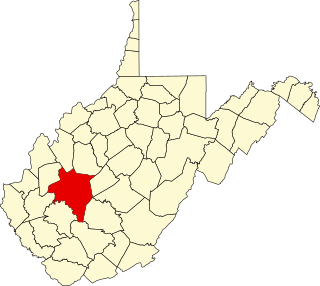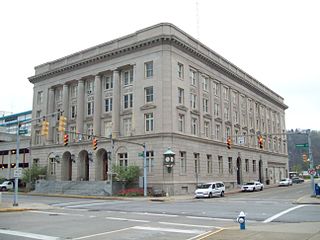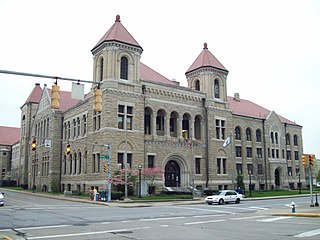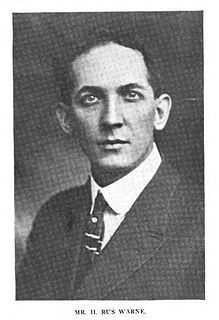
Charleston is the capital and most populous city of West Virginia. Located at the confluence of the Elk and Kanawha rivers, the city had a population of 51,400 at the 2010 census and an estimated population of 46,536 in 2019. The Charleston metropolitan area as a whole had an estimated 208,089 residents in 2019. Charleston is the center of government, commerce, and industry for Kanawha County, of which it is the county seat.

William Alexander MacCorkle, was a United States teacher, lawyer, prosecutor, the ninth Governor of West Virginia and state legislator of West Virginia, and financier.

The University of Charleston (UC) is a private non-profit university with its main campus in Charleston, West Virginia. The university also has a location in Beckley, West Virginia, known as UC-Beckley.
Malden — originally called Kanawha Salines — is an unincorporated community in Kanawha County, West Virginia, United States, within the Charleston metro area.

Charleston station is an Amtrak station in Charleston, West Virginia, United States, that is listed on the National Register of Historic Places and is served by the Cardinal. The Cardinal operates as Train 50 Eastbound towards Washington D.C. and New York City departing Chicago on Saturdays, Tuesdays, and Thursdays. The train operates as Train 51 Westbound towards Chicago departing New York on Wednesdays, Fridays, and Sundays. Trains only operate to the station on Wednesdays, Fridays, and Sundays.

This is a list of the National Register of Historic Places listings in Kanawha County, West Virginia.

Breezemont, also known as the Gen. C. C. Watts House, is a historic home located at Charleston, West Virginia. It was built about 1905 for Cornelius Clarkson Watts (1848–1930) an individual who contributed quite significantly to the history of both Kanawha County and the state of West Virginia. It is located atop Watts Hill overlooking much of Charleston, and is an example of vernacular Neo-Classical architecture.

Craik-Patton House is a historic home located at Charleston, West Virginia. It was built by James Craik and his wife, Juliet Shrewsbury, in 1834 in the Greek Revival style. It was originally located on Virginia Street in Charleston, but moved to its present site in 1973 to save it from the threat of demolition. It features four massive columns that support the extended center roof with pilasters placed above the front facade. It was faithfully restored and preserved for the public by the National Society of the Colonial Dames of America in the state of West Virginia and open for tours year round.

Laidley-Summers-Quarrier House, also known as Glenwood, is a historic home located at Charleston, West Virginia. It is a two-story gable roofed dwelling in the Greek Revival style and built in 1852.

Holly Grove Mansion, also known as Holly Grove Inn or Ruffner Mansion, is a historic home located at Charleston, West Virginia on the grounds of the West Virginia State Capitol. It is a large brick house with a front section made to accommodate three floors and rear section housing two. It features a massive two story, semi-circular portico at the front entrance. It was constructed originally in 1815 as the home of Daniel Ruffner, one of a family which helped develop the early salt industry in the Kanawha Valley. It gained its present-day appearance in about 1902 when new owner, John Nash, undertook substantial remodeling. In 1979, the mansion underwent an extensive rehabilitation when it became headquarters for the West Virginia Commission on Aging.

Samuel Starks House is a historic home located at Charleston, West Virginia.

Littlepage Stone Mansion, also known as The Old Stone Mansion, is a historic home located at Charleston, West Virginia. It was constructed in 1845 is one of only six houses within the City of Charleston that date to before the American Civil War. It was originally constructed as a two-story Federal style residence, with additions and improvements made in 1915 and 1936.

Sunrise, also known as MacCorkle Mansion, is a historic home located at Charleston, West Virginia. It was built in 1905 by West Virginia's ninth governor, William A. MacCorkle (1857-1930). It is a long, three-story stone mansion. Its gabled roof is dotted with dormers and chimneys and surmounts an intricate, but wide, cornice which gives the illusion that the house is smaller than it actually is. The Georgian structure rests on a bluff overlooking the Kanawha River, and from the northern portico one can see nearly the entire city of Charleston. The north side features four magnificent Doric, or neo-classic, columns which support the cornice and ashlar-finished pediment. In 1961 Sunrise Foundation, Inc., was formed for the purpose of purchasing the mansion and grounds.

Col. Henry Hewitt Wood House is a historic home located at Charleston, West Virginia. It is a two-story, white- painted brick house was formerly the seat of a large farmland and built in 1829-31 for Colonel Henry Hewitt Wood, a leading saltmaker. It is a slightly modified "L" shaped dwelling. The major elevation facing the Kanawha River is symmetrically divided among five bays and is centered with an especially broad entrance.

Charleston City Hall is a historic city hall located at Charleston, West Virginia. It was constructed in 1921 in the Neoclassical style. It is located opposite the Kanawha County Courthouse, at the center of downtown Charleston. The major, or entrance, elevation faces Virginia Street with monumental design features and walls clad in smooth gray limestone. The equally impressive limestone-faced Court Street facade presents a grand prospect which runs southward for nearly a block between Virginia Street and Kanawha Boulevard. These two elevations are entirely formal in design because they were intended to face the courthouse and principal city thoroughfare. The four-story building is centered with a colossal engaged colonnade of six fluted Doric columns, which rises three-stories in support of a massive cornice. The interior features a grand entrance lobby, and classically designed stairhall and council chambers.

Kanawha County Courthouse is a historic courthouse located at Charleston, West Virginia. It is located across from the Charleston City Hall, and is a block-long structure constructed in 1892 of rock-face masonry.

Elizabeth Harden Gilmore House, also known as Minotti-Gilmore House or Harden and Harden Funeral Home, is a historic home and national historic district located at Charleston, West Virginia. It is a 2+1⁄2-story, Classical Revival brick detached residential dwelling built by 1900 on an approximately one-half acre lot in a business area of town. It features a columned portico and has undergone some alteration and deterioration. It was the home and location of a funeral home operated by Elizabeth Gilmore, a prominent African American in the Kanawha Valley.

Garnet High School, also known as Garnet Career Center and Garnet Adult Education Center, is a historic African-American high school in Charleston, West Virginia. The school was established when "twelve African-American students in Kanawha County passed an entrance examination for high school level course work." It was named after Henry Highland Garnet, who was a former slave that became the United States’ ambassador to Liberia. It is a three-story, brick structure, constructed in 1928-29 from the plans of the prestigious Charleston architectural firm of Warne, Tucker, Silling and Hutchison, and dedicated December 2 to 4, 1929. The façade features a limestone-arched entrance containing two sets of double doors, transom light, and a limestone tympanum. Garnet was one of three high schools in the Kanawha Valley built for African-American students. It closed as a high school in 1956, following integration of the public schools, but has been used as a public resource building since that time.

The West Virginia Capitol Complex is a 18-acre (7.3 ha) historic district located along Kanawha Blvd., E., in Charleston, West Virginia. It dates from 1925 and was listed on the National Register of Historic Places in 1974.

Harry Rus Warne was a Charleston, West Virginia-based architect.






















